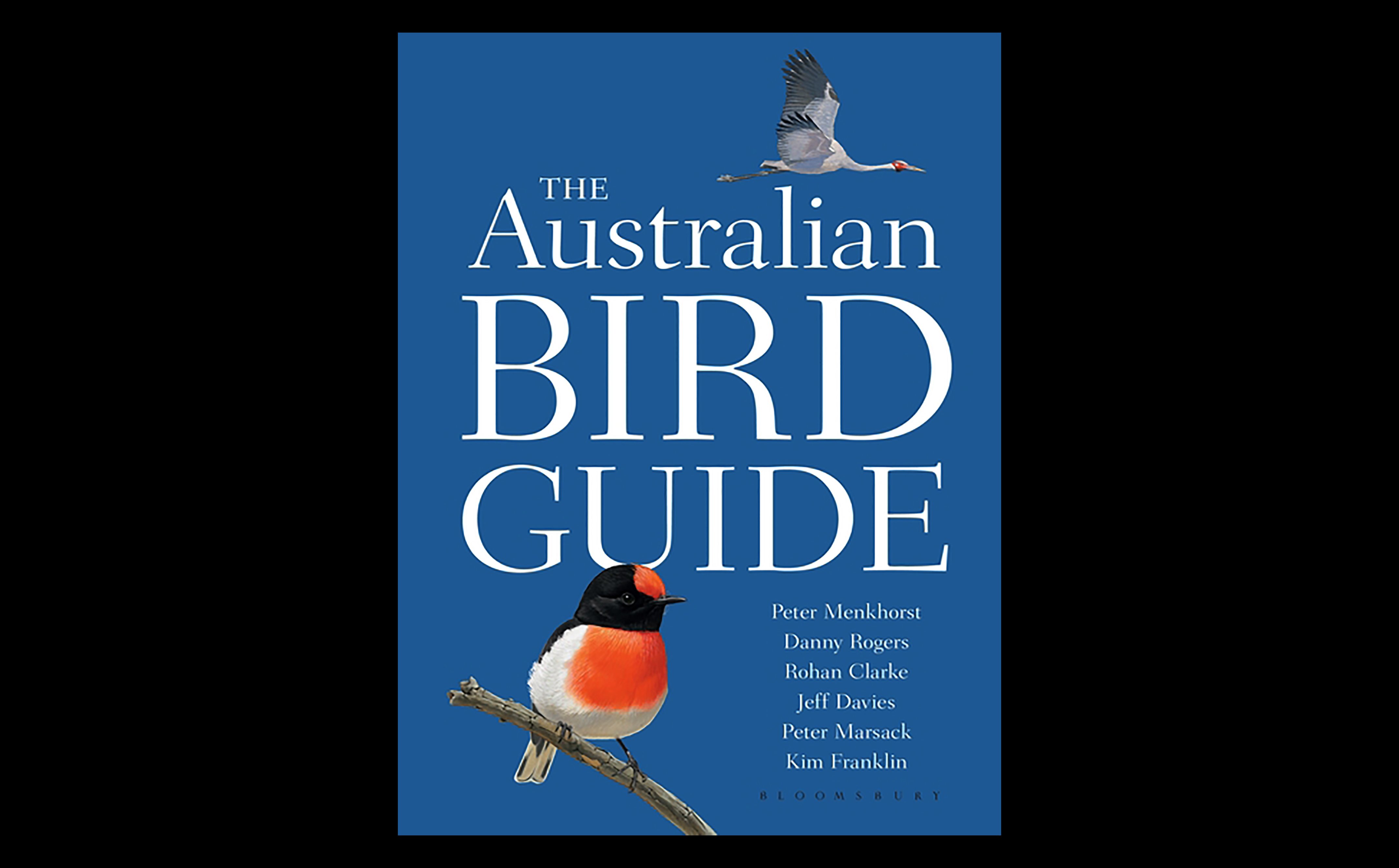
Are there birders out there who do not dream of birding Australia? Possibly birders who have already birded Australia (but, wouldn’t you want to go back?) or birders who live there (but, how can you bird it all?). It’s a place made for birding fantasies—a huge land mass that is also an island and also a continent far from any other land mass except for neighboring New Zealand, a geography that has given rise to an amazing range of endemic, resident, and migrant birds, from dainty, confiding Fairy-wrens to large (very large, second largest bird in the world), flightless Emus. But, of course, regular 10,000 Birds readers know this from beat writer, Australian birder Clare Morton, whose writings about the birds of Broome and other Australian areas have taught many of us about the joys of Australian birding.
So, I welcomed the opportunity to review The Australian Bird Guide. Authored by three writers– Peter Menkhorst, Danny Rogers, Rohan Clarke—and three artistis– Jeff Davies, Peter Marsack & Kim Franklin, developed over nine years under the auspices of CSIRO Publishing, a unit of Australia’s Commonwealth Scientific and Industrial Research Organisation, The Australian Bird Guide offers unprecedented comprehensiveness both in the number of birds covered and in the number of illustrations for each species. Its organization and content is unorthodox in several ways, which I think is exciting; new approaches to field guides give birders opportunities to rethink how we identify birds and a good excuse to buy yet another field guide.
This is a large, heavy book–6.8 x 1.3 x 9.7 inches, over 3 lbs–so I use the term “field guide” in the most flexible sense possible. Really, more of a car field guide, not one you can easily put in your backpack. Yet, the introduction makes clear that this is what the authors envisioned: an identification guide covering all birds found on the continent and its islands, excepting the Arctic territory, presenting the most important field marks in a way that the birder in the field can find them quickly, also showing all significant images of the bird as it might be seen in Australia, as an adult and juvenile, male and female, perched and flying.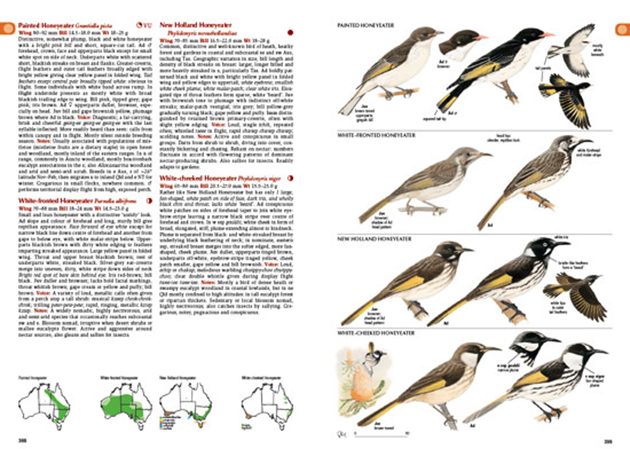
The guide covers 747 breeding residents or regular migrants, 29 introduced species, and 160 vagrants, a total of 936 species. There was a cut-off point at which birds could not be added, which explains why the Temminck’s Stint found by our own Clare and Grant in November 2015, a first for Australia, nor the recently found Nicobar Pigeon are, are not included. The authors emphasize in the Introduction the great degree to which the text and illustrations are based on current scientific information. Distribution maps are based on data gathered by Birdlife Australia and have an “unprecedented accuracy.” Scientific names have been reviewed by the Working Group on Avian Nomenclature of the International Ornithologists’ Union. Illustrations were created using diverse visual and physical source materials–skin collections from Australian museums and a database of over 300,000 photographs (plus, of course, the artists’ years of field experience).
Considering this adherence to scientific accuracy, it is intriguing that the authors have put aside a taxonomic form of organization and have instead opted for “a pragmatic field guide sequence… that groups bird families according to the broad biomes in which they are most likely to be encountered—marine, freshwater and terrestrial…” (p.2). The reasons are twofold–the rapidly changing taxonomic playing field and the obstacles these changes present to users. (Pretty much the same reasons presented so eloquently by Jochen in his classic post “Keep Your Taxonomy Out of My Field Guide”–Revisited.)
So, there are two basic sections–marine and freshwater birds (pp. 32-209), indicated by blue tabs on the pages, and terrestrial birds (pp. 210-531), indicated by brown page tabs. Within each group, birds in the same family are grouped together and birds in the same genus “usually occur consecutively.” The result is an organization that is sort of but not always arranged taxonomically. Falcons follow hawks in the book, for example, while falcons follow hoopoes in the 2015 IOC World Bird List, and I think most of us (I’m looking at you, Jochen) will agree that the guide’s arrangement makes sense intuitively and pragmatically, if not taxonomically.
Each family group begins with a small box summarizing the characteristics of the family in Australia. Honeyeaters are “active, noisy and pugnacious” and there are a lot of them–76 species–in Australia. Only one species of penguin breeds on the Australian mainland; five additional species breed on sub-Antarctic islands. The family descriptions are much longer in the first section, with extensive descriptions the challenges of identifying tube-nosed seabirds and lengthy descriptions of the identification challenges for shorebirds, terns and gulls.
Each Species Account consists of text on the left-hand page, distribution maps on the bottom of the page, and illustrations on the right. The text account starts off with common name, scientific name and a ‘Likelihood of encounter score’–a symbol indicating abundance in the bird’s appropriate habitat. The large font and brown color used for this initial line help set each Species account apart visually. The colored font is also used to indicate measurements, voice, and notes.
Measurements come next–wing length, bill length and weight. Another departure from the norm! The authors felt that the usual measurements given in field guides–total length and wingspan–were not really valid, being based on skins, which are often different in size than live birds, or on poor data. The measurements they give–wing length when closed and bill length–are based on published data and, they think, more accurate. (Additional measurements are given for certain species, like penguins.) This may be true, but I think it is a very different way of looking at species size and will take some getting used to by the guide’s users.
Most of the Species Accounts text is devoted to key identification features overall, and key identification features for aging and sexing the bird in the field. Use of bolded abbreviations and symbols help pinpoint exactly which plumage is which (adult, juvenile, immature, male, female) and help break up the sea of descriptive text, which in some cases is quite long. Subspecies are described under “Geographic variation.” Interestingly, the authors don’t attempt to give full descriptions of species, referring the user to the guide’s illustrations and the encyclopedic Handbook of Australian, New Zealand, and Antarctic Birds (which several of the authors also worked on).
Voice is described using both descriptive terms and transcriptions of calls. And “Notes” contains information on distribution, habitat, migration patterns, noteworthy sightings for vagrants, as well as bits on behavior and nests. The authors state in the introduction that they want to “describe something of the experience of observing each species.”
Illustrations are remarkably detailed and lovely, showing the different plumages of each species–adult, juvenile or immature, male and female, plus flight illustrations.There are a total of 4700 images! The swift flight illustrations are particularly striking, showing details of feather scalloping while giving such an impression of movement that you expect the White-throated Needletail and Fork-tailed Swift to lift up off the page. And, the two pages of Rosellas–six species, three types, 51 illustrations–depict each parrot with minute color and pattern specificity; the plates are a feast of greens and reds and blues in all possible variations. I also love the little touches–the close-ups of the tails of the Fantails, the small images of birds in the nest or foraging for food, the dive sequence of the Australasian Gannet. These “vignettes” are sadly limited due to space considerations.
The Introduction explains that although each artist has years of experience and a unique style, an effort was made to be stylistically consistent, and, as part of that, an artist did most, if not all, of one family. Each plate is signed with the artist’s initials, which makes for an interesting exercise in comparison. You can see examples of each artist’s style in the plates shown here: Jeff Davies, who did 40% of the artwork and also acted as artwork manager, did the Sandpiper, Gannet and Cockatoo plates, Peter Marsack, who worked on many of the passerine plates, created the Honeyeater plate, and Kim Franklin, who focused on non-passerines, is responsible for the Penguin and Kingfisher plates.
There is a consistency in the placement of the illustrations that helps give order to the many images–adults on the far right, juveniles on the far left, other forms in-between, rarities at the bottom of the page when possible. Species are separated by thin but visible lines. Each image is labelled for age, sex, subspecies, and, for shorebirds, by time of year, indicating fresh or worn plumage. Also, important identification features are spelled out. All main images on a plate are shown in scale (as much as possible, the Introduction cautions), and each plate has a scale bar at the bottom to help give a sense of size.
The distribution maps have a lot of potential; they give coastal and at-sea distributions for marine and shore birds, indicate internationally significant sites for migratory shorebirds, regular and irregular occurrence, and distribution of subspecies where relevant. The maps, however are small. No smaller than most field guides maps, but then most field guide maps do not offer so much information. It is a challenge reading the maps charting subspecies distribution and movement.
The extensive introductory material explains how The Australian Bird Guide was constructed; gives a tutorial on Identifying Birds, including bird topography diagrams; a section for beginning birders on Birding in Australia (where, when, equipment, ethics, documentation); and, as if making up for the lack of a strictly taxonomic organization, A Guide for Birders to the Evolution and Classification of Australian Birds by ornithologist Leo Joseph. Back of the book material includes a Checklist of Species (according to the 2015 IOC World Bird List version 5.4), a Glossary, and an Index.
And, this is where I have my major problem with The Australian Bird Guide. I love the illustrations, I respect the text, and I hate the index. It lists every species name, common and scientific, alphabetically by the full name. So, for example, Glossy Black-Cockatoo is listed in the G section, under Glossopsitta pusilla and before Glossy Ibis.. Now, let’s say you are in the field and you see a bird you think may be a Cockatoo. Or, maybe a Black-Cockatoo. You don’t remember where it is in the guide, so you go to the index and look up Cockatoo. And, find nothing. You go to the B’s for Black-Cockatoo. And find nothing. The only way to find this bird is to remember the exact name–Glossy Black Cockatoo. Or, the scientific name–Calyptorhynchus lathami.
There are other ways to find birds in this guide. There is a Visual Quick Reference to Bird Groups on the inside front cover, where you can scan bird images and hopefully find the image of the Gang-Gang Cockatoo, which tells you that the Cockatoo section begins on page 256. Or, you can use the Alphabetical Quick Reference Guide to Bird Groups in the front, which lists cockatoos alphabetically. I tried using both finding aids while writing this review and found them less than satisfactory. I don’t think visually, so the Visual Guide takes time. The Alphabetical Guide is printed in the smallest, thinnest font imaginable, making it hard to read. No, what I really wanted was an index that indexed bird names by family (Black-Cockatoo–Glossy). For some reason, the authors think that consulting an index is the worst way to find information (they write that their “pragmatic” organization “reduces the likelihood of having to resert to the index to find a bird group or species”). I strongly disagree.
One question kept occurring to me as I examined The Australian Bird Guide: How does it compare to other Australian birding field guides? And, there are many. Fortunately, Clare graciously send me examples of pages and plates from her field guide collection, using kingfisher as the sample bird. She comments, “Each field guide we have differs in information & we have all of the guides available. Some offer nest information, egg information, breeding timeline, in flight views, etc. Each offers something different & you do feel that one guide does not cover everything at all!”
The Field Guide to the Birds of Australia, 9th edition by Graham Pizzey and Frank Knight, edited by Sarah Pizzey (2012):
Field Guide To The Birds Of Australia, 7th edition by Nicholas Day and Ken Simpson (20o4; there is an 8th, 2010 edition as well):
The Slater’s Field Guide to Australian Birds (1993, there is also a 2nd ed., 2009):
Field Guide To Australian Birds, rev. by Michael Morcombe (2000):
And, here is a kingfisher plate from The Australian Bird Guide:
I know it’s not easy to read the text of these images, but I think they give you an idea of the artwork and plate organization of each of these major Australian bird field guides. Eggs and nests are a major topic of information for some guides; Slater, as you can see, illustrates eggs, and Simpson and Day and Morcombe each offer sections on nesting behavior. Each of these guides covers most of Australia’s birds, with The Field Guide to the Birds of Australia, 9th edition by Pizzey and Knight coming up as the most competitive–about 867 species covered, including vagrants, compared to The Australian Bird Guide’s 936 species, including vagrants. The difference is that The Australian Bird Guide covers the outlying islands like Christmas Island and Pizzey and Knight do not.
I was able to get a copy of The Field Guide to the Birds of Australia, 9th edition, so I can also tell you that it is almost as large and as heavy as The Australian Bird Guide, and has a better index. It’s a tough comparison. In the end, The Australian Bird Guide edges out ahead by currency of information, denseness of text, and quality and quantity of illustrations. But, as Clare makes clear, for the Australian birder there are many reasons to own more than one guide, just as the U.S. birder is apt to own a copy of the Sibley’s and National Geographic field guides.
The big question is which guide do you purchase if you are a U.S. (or other foreign country) birder visiting Australia? I am hoping that The Australian Bird Guide is available in eBook or app format by the time I bird Australia. That would solve the index problem and give me a guide that combines clarity of organization with comprehensive identification information with excellent artwork depicting species in all forms. Meanwhile, I will experience Australian birding experiences vicariously, through Clare’s posts and through the birding blog of Australia-resident friend R. Bruce Richardson. And, I will study these field guides, drinking in the colors of the finches (Gouldian Finch!), examining the subtle differences of the Emu-wrens (look at those tails!), admiring the courtship structures of the Bowerbirds (complete with decorations), wondering how easy it is to view the penguins (many are labelled vagrant). Birding Australia may be the stuff of fantasy, but The Australian Bird Guide helps to keep the dream grounded in reality.
The Australian Bird Guide
by Peter Menkhorst, Danny Rogers, Rohan Clarke, Jeff Davies, Peter Marsack & Kim Franklin
Princeton Univ. Press (U.S.), 2017. [published by Bloomsbury Publishing under the Christopher Helm imprint in the U.K., by CSIRO Publishing in Australia]
566 pages; 6.8 x 1.3 x 9.7 inches
ISBN-10: 069117301X; ISBN-13: 978-0691173016
$39.95 in U.S. (slightly less from Amazon)

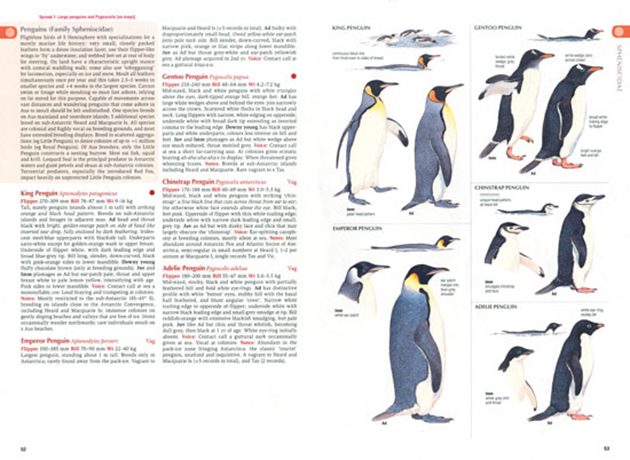
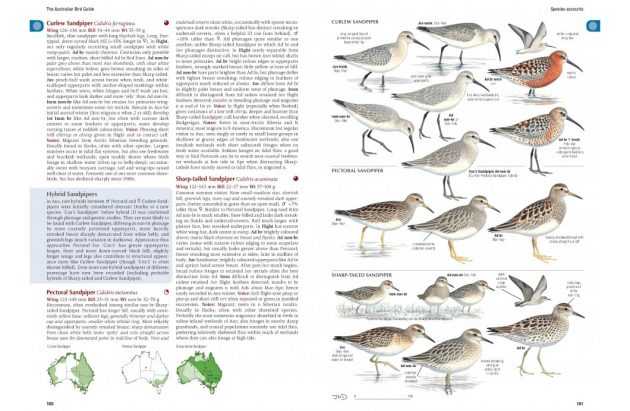
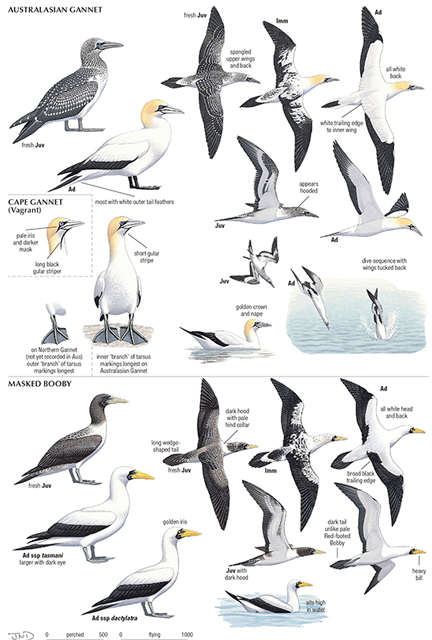
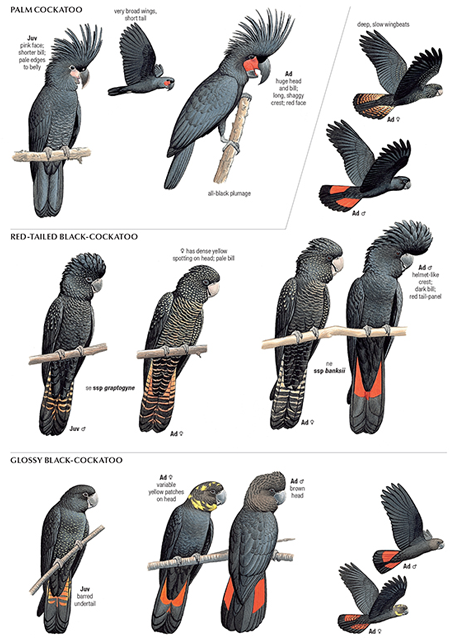
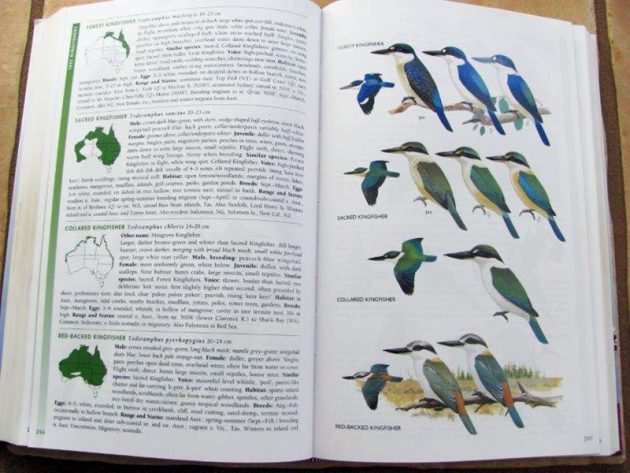
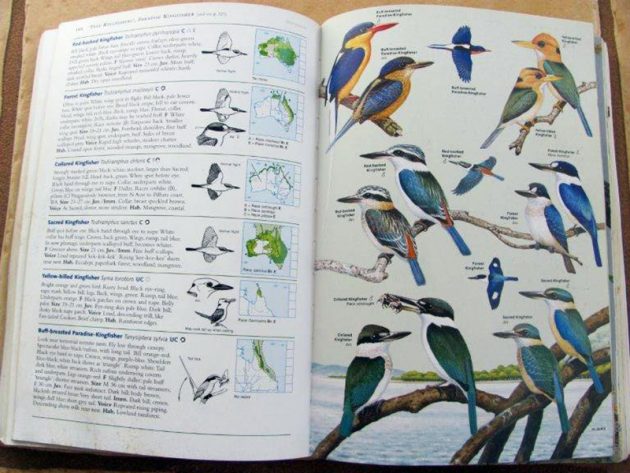
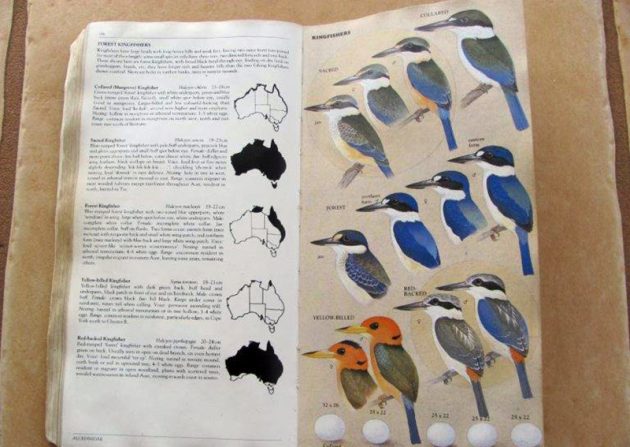
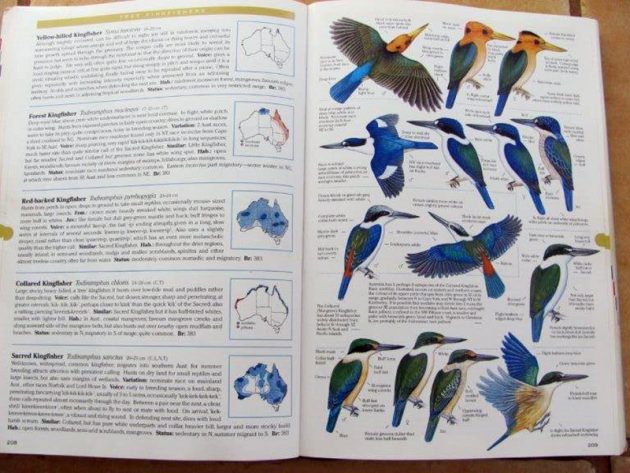
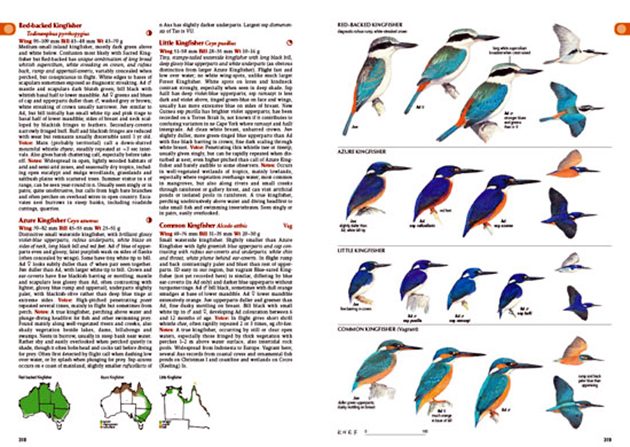
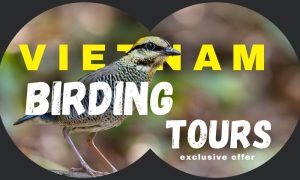









I really like the pics in the new guide, and the ‘likelihood of encounter’ graphics keep me buoyant, but that index is just shocking.
I also found the index format irritating (not sorted by most significant part of the name). There is now a revised index available in electronic format. This index lists species under both their scientific name, and also under their common name, and common family name.
It is available here…
http://www.publish.csiro.au/book/6520#extra
Do any of the AUS field guides show the time of year in the distribution map? I always have found this very useful in other field guides, but from the images above, none of the AUS guides do it?
The field guides tend to show a bird species range as far as “more likely” or “less likely” in different colours and “cross overs” of sub species. There is so much variation in the bird movement each year due to the forever changing climate it would appear harder to include the time of year other than for migratory birds. The field guides guide humans, but birds are forever challenging the field guides in Australia!
Thank you, Emma, for letting us know about the Index! That is a huge improvement in the usability of this identification guide. It’s nice to know that other birders out there also value indexes.
And, thank you Clare, for answering Aaron’s question.
Just purchased The Australian Bird Guide. Not my intention, but a copy of the Field guide (Knight) wasn’t available. Great detail but extremely heavy book. Too large for a Field guide. Still need more than one book!